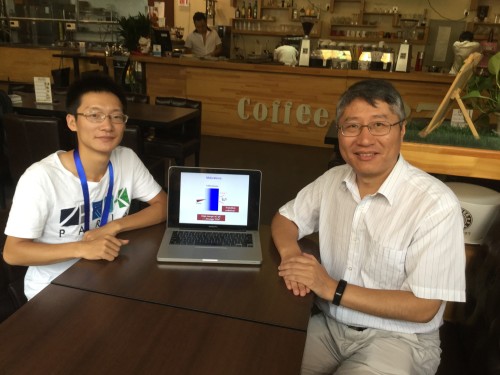
Terahertz generators: Gianqian Liao (left) and Yutong Li.
By Hamish Johnston in Beijing
Today was the last day of the Fall Meeting of the Chinese Physical Society here in Beijing and this morning I grabbed a coffee with Yutong Li and Giuqian Liao. I was hoping to learn more about their work that we covered in May in “Coherent terahertz radiation created in laser plasmas“.
Their technique involves firing a powerful laser pulse at a thin metal foil. This creates a plasma in which electrons are accelerated to high energies before bursting out of the foil. When they emerge, coherent terahertz radiation is given off.
Having a practical source of coherent terahertz radiation would be a boon to physicists studying materials such as superconductors and graphene. And Li told me that a pulse-driven system would allow “pump and probe” experiments to be done.
But before that can happen, the technique must be refined. One area for improvement is the collimation of the terahertz radiation, which is currently emitted over a wide range of angles. Li says that it may be possible to have the radiation focused into a better-collimated beam by using a curved target rather than a flat film.
However, making a better terahertz source is not their priority at the moment. Li, who works at the Institute of Physics of the Chinese Academy of Sciences in Beijing, and Liao (who has just moved to Shanghai) are working on ways to determine the properties of electrons in the plasma using the emitted terahertz radiation. Li says that such analytics could be particularly useful to physicists working on “fast ignition fusion”. This aims to achieve nuclear fusion by firing an ultrashort, extremely powerful laser pulse at a compressed sample of hydrogen.
Guidelines
Show/hide formatting guidelines
this text was deletedwhere people live in harmony with nature and animals</q>
Some text